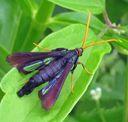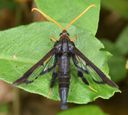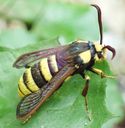Sesiinae
Sesiinae
Classification
- Phylum: Arthropoda
- Subphylum: Hexapoda
- Class: Insecta
- Order: Lepidoptera
- Superfamily: Cossoidea
- Family: Sesiidae
- Subfamily: Sesiinae
Pronunciation
How to pronounce Sesiinae: //sɛˈsaɪ.ɪˌniː//
These audio files are automatically generated. While they are not always 100% accurate, they are a good starting point.
Images






Summary
Sesiinae is a subfamily of clearwing moths known for their transparent wings and wasp-like appearance, contributing to their ecological roles as pollinators and as part of the food web.
Physical Characteristics
Sesiinae are characterized by their clear wings and slender bodies, often resembling wasps. They possess a distinctive pattern of spots on their wings and a generally elongated shape compared to other moths.
Identification Tips
Look for clear, transparent wings with a few dark spots or markings, and a body that resembles a wasp. They are usually found in habitats where their host plants are located, and are most active during the day.
Habitat
Sesiinae are often found in gardens, forests, and grasslands where their larval host plants grow, typically within specific plant communities.
Distribution
Members of Sesiinae can be found in diverse regions across the world, notably in temperate and tropical areas.
Diet
Adult Sesiinae moths typically feed on nectar from flowers, while larvae are often borers in woody plants or herbaceous stems.
Life Cycle
The life cycle of Sesiinae generally includes egg, larval, pupal, and adult stages. Larvae bore into plant tissues, which is critical for their development.
Reproduction
Females typically lay eggs on or near host plants, with larvae developing within the plant tissues after hatching.
Predators
Sesiinae moths may fall prey to birds, parasitoid wasps, and other insect predators that are attracted to their adult form or larvae.
Ecosystem Role
As pollinators, adult Sesiinae moths contribute to the reproduction of flowering plants; larvae affect their host plant populations through their boring behavior.
Economic Impact
Some species cause damage to economically important plants by burrowing into stems and roots, which can affect crop yield.
Collecting Methods
- Light traps
- Netting during flight hours
- Baiting with host plants
Preservation Methods
- Freezing to kill specimens
- Pinning for display
- Setting in glass jars with alcohol
Evolution
Sesiinae are part of the larger order Lepidoptera, which is characterized by wings covered in scales. Their clear wings are an adaptation thought to minimize predation by mimicking wasps.
Similar Taxa
- Aegeriinae
- Melittiinae
- Paranthreninae
- Synanthedoninae
Misconceptions
Due to their wasp-like appearance, Sesiinae moths are often mistaken for harmful insects, potentially leading to unnecessary fear or avoidance.
Tags
- moths
- clearwing
- Sesiinae
- Lepidoptera